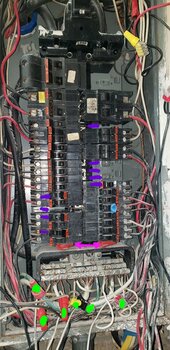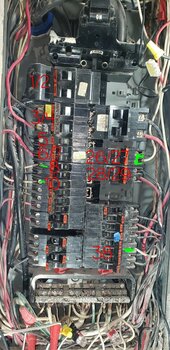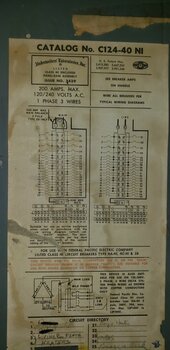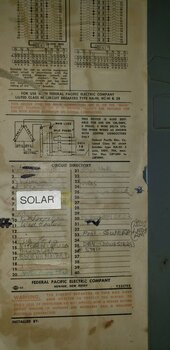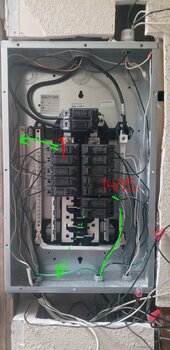CaliSunHarvester
Solar Enthusiast
In the past, I built an off-grid 24V system with a 3kW inverter and 3kW panels, which I use to power a detached workshop, and to charge a PHEV. This has worked well for a little over a year. So I felt confident, to build a somewhat larger system with 25kW storage on 48V basis. This one should power a portion of my house. I put the inverter/ charger (SGP 10kW model) in a separate shed and ran the output into the room where the PoCo's main panel is.
I added a new blank panel left of it.
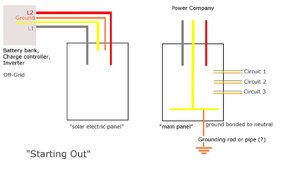
This first diagram shows the existing panel. The right panel is the old one, gets power from the utility and has a bunch of breakers and tons of wires in it. The left one is blank and clean.
My expectation was to identify wires that belong together e.g. for circuit 2 -- 1 hot (black), 1 neutral and 1 ground wire.
I would then swing these 3 over to the new panel.
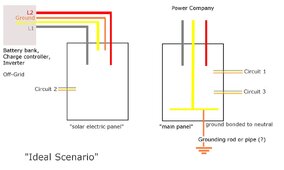
Unfortunately, I very quickly realized that there were 40 circuits with 40 black (or red) wires, but only 5 bare copper ground wires. It seemed impossible to match them. Also, I had found places in the house with other grounds, e.g. inside a wall of a bathroom, a white wire was hooked up to a metal pipe.
So, instead, I could only move over a pair of black and white:
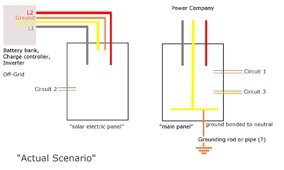
-- PAUSE --
This alone got me uncomfortable already. Knowing that my new "off grid circuit 2" was grounded -- who knows where. Keep in mind, there are some pretty big neutrals and big grounds coming into the main panel. They could belong to the 30A, 60A and 100A breakers. But it's also possible that the ground for circuit 2 is attached to one of those.
However, it has been working so far. Today, I was about to move my 8th circuit over, from the right to the left. The original panel has space for 40 breakers, meaning 40 black wires, but not 40 white wires either. Remember how I said "only 5 bare copper ground wires"? I should have added "at most 20 white neutrals".
And since I already swung over 7 white ones, there were like 10 left for me.
And none of them seemed to belong to the 8th circuit. I identify the matching neutral by creating an artificial "short" in the circuit (both panels powered off, of course), and then I look which of the white wires shows continuity with the black wire that I plan to move over.
I removed all white wires in the right panel from the bus bar, and the black one still had continuity with the bus bar on the right.
Worse, I noticed continuity with the left panel's bus bar.
My explanation is that some circuits in the old panel have their neutrals joined before they come into the panel, e.g. circuit 7 and circuit 8 are on one neutral. This matches up with the facts that 80% of the breakers are 15A only but the wire looks like 12 gauge and even 10 gauge.
When I moved #7 to the new panel, I already moved the neutral for #8.
So, today, I just hooked up the hot wire of #8 to a new breaker and hooked it up in the new panel.. things work
But now I'm really scared because of the continuity of the neutral bars in the 2 panels.
What do I need to do?
I should also add that the old electrical panel has a grid-tied solar panel installation. 40 solar panels with 2 inverters that are feeding into a double pole 30A breaker in the old panel. I am in California. So there is a rapid disconnect .. somewhere (not sure).
I added a new blank panel left of it.

This first diagram shows the existing panel. The right panel is the old one, gets power from the utility and has a bunch of breakers and tons of wires in it. The left one is blank and clean.
My expectation was to identify wires that belong together e.g. for circuit 2 -- 1 hot (black), 1 neutral and 1 ground wire.
I would then swing these 3 over to the new panel.

Unfortunately, I very quickly realized that there were 40 circuits with 40 black (or red) wires, but only 5 bare copper ground wires. It seemed impossible to match them. Also, I had found places in the house with other grounds, e.g. inside a wall of a bathroom, a white wire was hooked up to a metal pipe.
So, instead, I could only move over a pair of black and white:

-- PAUSE --
This alone got me uncomfortable already. Knowing that my new "off grid circuit 2" was grounded -- who knows where. Keep in mind, there are some pretty big neutrals and big grounds coming into the main panel. They could belong to the 30A, 60A and 100A breakers. But it's also possible that the ground for circuit 2 is attached to one of those.
However, it has been working so far. Today, I was about to move my 8th circuit over, from the right to the left. The original panel has space for 40 breakers, meaning 40 black wires, but not 40 white wires either. Remember how I said "only 5 bare copper ground wires"? I should have added "at most 20 white neutrals".
And since I already swung over 7 white ones, there were like 10 left for me.
And none of them seemed to belong to the 8th circuit. I identify the matching neutral by creating an artificial "short" in the circuit (both panels powered off, of course), and then I look which of the white wires shows continuity with the black wire that I plan to move over.
I removed all white wires in the right panel from the bus bar, and the black one still had continuity with the bus bar on the right.
Worse, I noticed continuity with the left panel's bus bar.
My explanation is that some circuits in the old panel have their neutrals joined before they come into the panel, e.g. circuit 7 and circuit 8 are on one neutral. This matches up with the facts that 80% of the breakers are 15A only but the wire looks like 12 gauge and even 10 gauge.
When I moved #7 to the new panel, I already moved the neutral for #8.
So, today, I just hooked up the hot wire of #8 to a new breaker and hooked it up in the new panel.. things work
But now I'm really scared because of the continuity of the neutral bars in the 2 panels.
What do I need to do?
I should also add that the old electrical panel has a grid-tied solar panel installation. 40 solar panels with 2 inverters that are feeding into a double pole 30A breaker in the old panel. I am in California. So there is a rapid disconnect .. somewhere (not sure).
Last edited:





